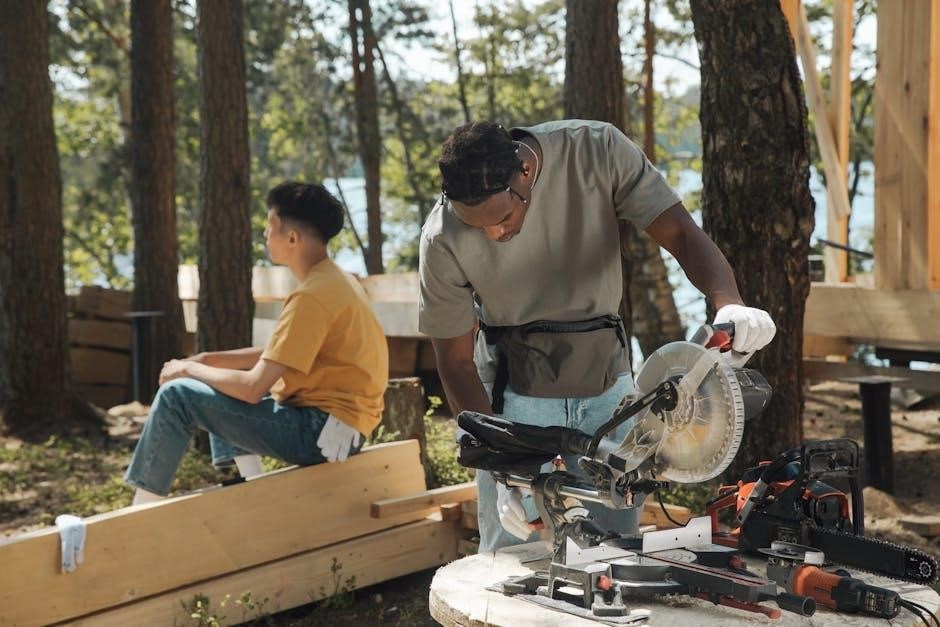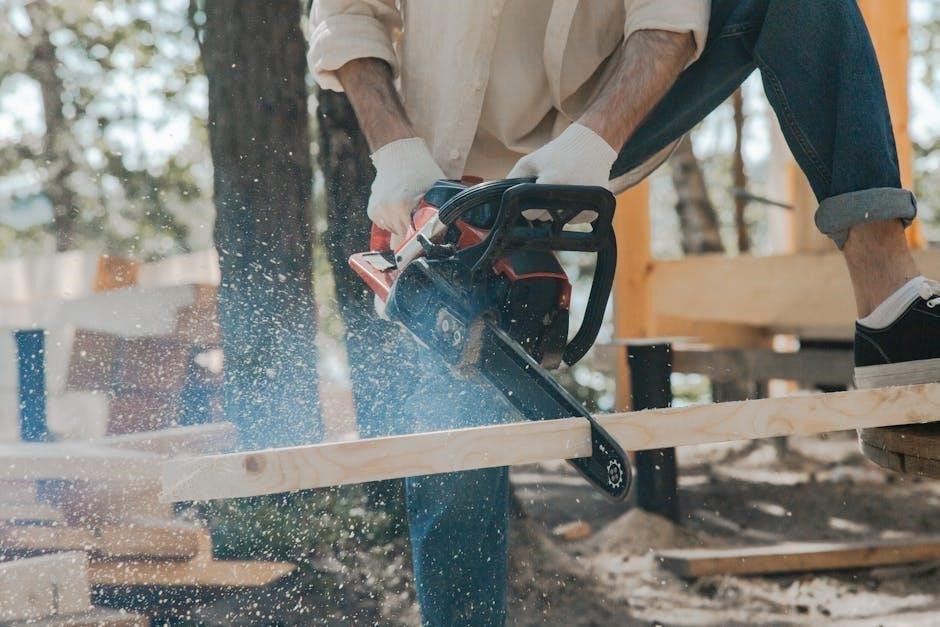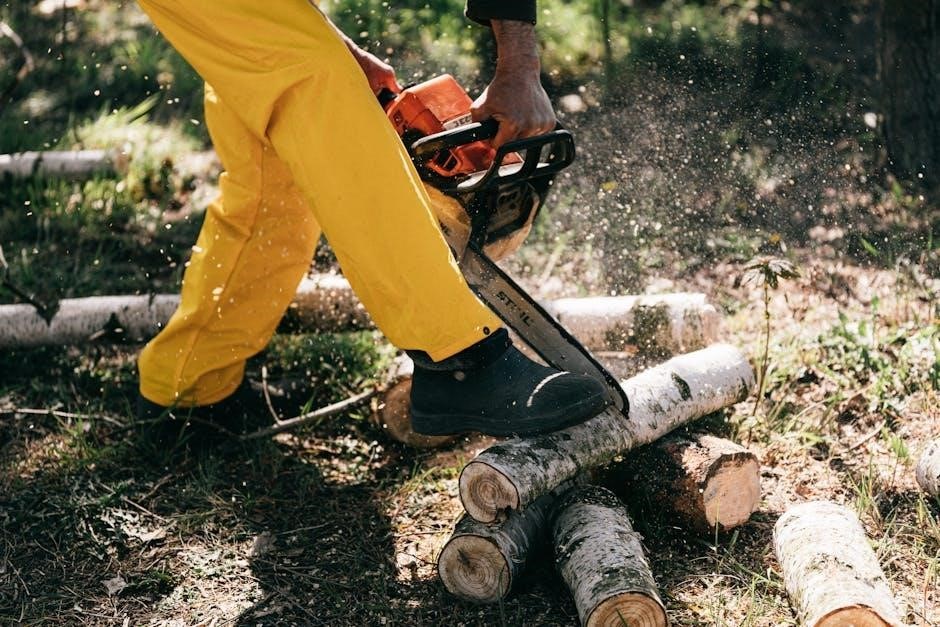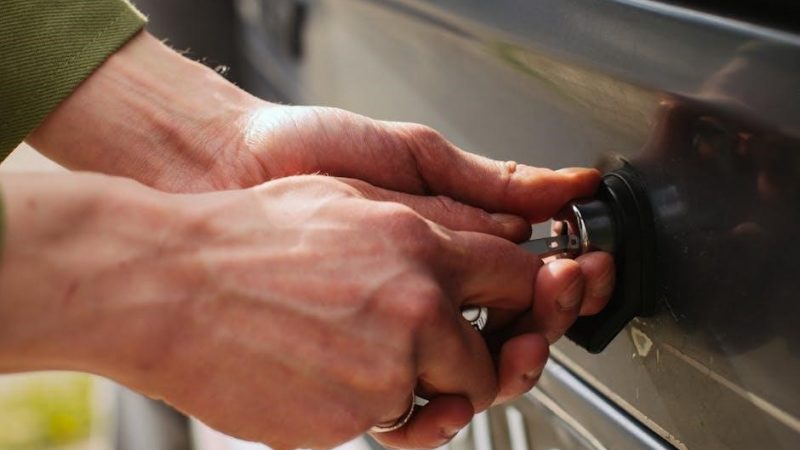chainsaw sharpener manual

A dull chainsaw chain can hinder productivity and safety, making sharpening essential. Using a chainsaw sharpener ensures a sharp, efficient cut, reduces wear, and prolongs chain life. This guide provides a comprehensive approach to sharpening your chainsaw chain effectively and safely.
Types of Chainsaw Sharpeners
Chainsaw sharpeners come in various forms, each designed to suit different needs and preferences. The most common types include manual files, electric sharpeners, and bench-top sharpeners. Manual files are the most affordable and portable option, requiring manual effort to sharpen each cutter. They are ideal for occasional use and those comfortable with hands-on sharpening. Electric sharpeners, on the other hand, offer convenience and speed, automatically sharpening both left and right teeth at precise depths. Bench-top models are sturdy, versatile, and often come with additional features like depth gauges and angle adjustments, making them suitable for frequent or professional use. Additionally, some sharpeners include accessories like depth gauges to ensure rakers are properly aligned. Each type has its unique benefits, catering to different skill levels, budgets, and sharpening frequencies. Choosing the right one depends on your specific needs and the level of precision required for your chainsaw chain.

Choosing the Right Chainsaw Sharpener
Selecting the appropriate chainsaw sharpener is crucial for achieving optimal results. Begin by considering your sharpening frequency and skill level. Manual files are ideal for infrequent use and those who prefer a budget-friendly, portable option. They require practice to master but offer precision control. For those who value convenience, electric sharpeners are a superior choice, delivering quick and consistent results with minimal effort. Bench-top models are recommended for professionals or heavy users, as they provide advanced features like adjustable angles and depth gauges. Additionally, consider the compatibility of the sharpener with your chainsaw chain, ensuring it accommodates the chain’s pitch and tooth size. Some sharpeners come with accessories like dressing bricks and templates, which aid in maintaining the grinding wheel and ensuring accurate sharpening. Lastly, assess your budget; manual files are cost-effective, while electric and bench-top models involve a higher initial investment but offer long-term efficiency. By evaluating these factors, you can select a sharpener that aligns with your needs and enhances your chainsaw’s performance.
Safety Precautions
Safety is paramount when sharpening a chainsaw chain. Always wear protective gear, including gloves, safety glasses, and a dust mask, to prevent injuries from flying metal shavings or debris. Ensure the chainsaw is securely clamped or held in a vise to prevent movement during sharpening, which could lead to accidents. Keep loose clothing and long hair tied back to avoid entanglement. Before starting, disconnect the spark plug or power source to eliminate any risk of accidental startup. Maintain a clean and well-lit workspace to enhance visibility and reduce hazards. Be cautious when handling sharp files and avoid applying excessive pressure, as this can cause loss of control. Never sharpen a chainsaw chain while it is attached to the saw without proper clamping. Additionally, keep children and pets away from the workspace. Regularly inspect files and sharpeners for wear and damage, ensuring they are in good working condition. By adhering to these precautions, you can minimize risks and ensure a safe sharpening process. Always refer to the manufacturer’s guidelines for specific safety recommendations tailored to your equipment.
Step-by-Step Sharpening Process
Secure the chainsaw, tighten the chain, and mark the starting tooth. Use a file guide to maintain angle consistency. Sharpen cutters, then adjust rakers for proper depth. Repeat for all teeth, ensuring uniform sharpness and proper chain alignment for optimal performance.
Preparing the Chainsaw
Before sharpening, secure the chainsaw to a stable work surface using a tabletop clamp or vise. Tighten the chain by adjusting the tension screw until it is snug but still movable. Mark the starting tooth with a permanent marker or painters tape to track your progress. Ensure the chainsaw is clamped firmly to prevent movement during sharpening. Place the chain in the correct position, either right-side up or upside down, depending on what feels most accessible. Double-check that the chain tension is appropriate—tight enough to prevent shifting but loose enough to allow easy rotation. This setup ensures safety and consistency throughout the sharpening process. Proper preparation is crucial for achieving evenly sharpened cutters and rakers, which are essential for optimal chainsaw performance. By securing the saw and preparing the chain, you create a stable environment for precise filing and adjustments. This step lays the foundation for a successful sharpening process. Always ensure the chain is tightly secured to avoid accidents and maintain control during sharpening. Proper preparation is key to achieving professional results.
Filing the Cutters
Begin by selecting a round file that matches the diameter of your chainsaw’s teeth, as specified in the owner’s manual or on the chain itself. Position the file at the factory-recommended angle, typically 25-30 degrees, aligning it parallel to the chain’s etched guide marks. Hold the file level and flat, with about 20% of its diameter above the tooth. Gently push the file across the cutter in one smooth motion, applying light pressure. Repeat this process 3-10 times per tooth until the cutter is sharp and shiny. Alternate between cutters, sharpening every other tooth to maintain balance. Use a marker or painters tape to track your progress and avoid sharpening the same tooth twice. For consistency, count the strokes for the first tooth and apply the same number to subsequent ones. After sharpening, use a flat file to smooth any burrs. This method ensures even sharpening and prevents uneven wear. Always maintain the correct angle and pressure to achieve optimal results. Proper filing of the cutters is essential for restoring your chainsaw’s cutting efficiency and safety.
Adjusting the Rakers
After sharpening the cutters, the next step is to adjust the rakers, which are the small teeth that regulate the depth of the cut. Use a depth gauge to ensure the rakers are at the correct height. Place the gauge over the chain and push it forward until it contacts a raker. If the raker is too high, it needs to be filed down. Hold a flat file at a 90-degree angle to the chain and gently file the raker until it aligns with the top of the gauge. Repeat this process for all rakers, maintaining consistent height to ensure even cutting performance. Be careful not to file too aggressively, as this can damage the chain. For added precision, slide the gauge back slightly while filing to avoid accidentally filing the gauge itself. After adjusting, use the flat file to smooth any rough edges on the rakers. Properly adjusted rakers ensure efficient cutting and prevent the chain from digging too deeply into the wood. This step is crucial for maintaining the chain’s effectiveness and prolonging its lifespan.
Final Checks
Once the sharpening process is complete, perform a series of final checks to ensure your chainsaw is ready for use. First, loosen the chain tension slightly to allow for proper movement. Inspect the chain for any remaining dull spots or uneven cutters. If necessary, repeat the sharpening process on any problematic teeth. Next, check the rakers to confirm they are all at the same height and aligned with the depth gauge. This ensures consistent cutting performance.
Use a soft cloth to wipe away any metal shavings or debris from the chain and bar. Re-tighten the chain to the recommended tension, ensuring it moves smoothly but doesn’t sag. Finally, apply a generous amount of bar and chain oil to lubricate the chain and prevent rust. Perform a test cut on a small log to verify the chain’s sharpness and cutting efficiency. If the chainsaw cuts smoothly and evenly, the sharpening process was successful. Regular final checks help maintain the chainsaw’s performance and extend its lifespan. Always store the chainsaw in a dry place with the chain covered to protect it from the elements. Proper maintenance ensures your chainsaw remains a reliable tool for years to come.

Maintenance and Storage
Proper maintenance and storage of your chainsaw sharpener and chainsaw are crucial for longevity and performance. After each use, clean the sharpener by removing metal shavings and debris with a soft brush or cloth. Store the sharpener in a dry, cool place to prevent rust and damage. For electric sharpeners, unplug them and ensure all moving parts are free from dust and residue.
Regularly inspect the sharpener for wear and tear. Replace worn-out grinding wheels or files as needed. Lubricate any moving parts according to the manufacturer’s instructions to maintain smooth operation; Store the chainsaw with the chain covered to protect it from moisture and rust. Apply a thin layer of oil to the chain and bar to prevent corrosion during storage.
Check the chain tension periodically and adjust as necessary to prevent sagging. Store the chainsaw in a well-ventilated area, away from direct sunlight and flammable materials. Proper maintenance ensures your chainsaw sharpener remains efficient and your chainsaw stays in optimal condition, ready for the next use. Regular care extends the lifespan of both tools and enhances their performance.

Troubleshooting Common Issues

When using a chainsaw sharpener, several common issues may arise. One of the most frequent problems is uneven cutting, which can result from improper filing angles or inconsistent sharpening. To resolve this, ensure the file is aligned correctly and that the same number of strokes is used for each cutter. Another issue is the chain cutting in an arc, often caused by dull cutters or improper filing angles. Sharpening the chain more carefully and maintaining consistent pressure can address this. If the chain becomes too tight during sharpening, it may not move freely. Simply loosen the tension-adjusting screw slightly to allow proper movement;
If metal shavings accumulate in the file, tap it gently on a hard surface to clear them. For rakers that are too high or low, use a depth gauge and flat file to level them evenly. Always consult the manufacturer’s instructions for specific troubleshooting tips, as different sharpeners may have unique maintenance requirements. Regularly inspect and clean the sharpener to ensure optimal performance and extend its lifespan. Proper care and attention can prevent most issues and keep your chainsaw operating efficiently.
Sharpening your chainsaw chain is a straightforward process that significantly enhances performance, safety, and efficiency. By mastering the use of a chainsaw sharpener, you can extend the life of your chain and ensure precise cuts. Remember to always follow safety guidelines, use the correct tools, and maintain proper technique. Regular sharpening not only improves cutting quality but also reduces wear on the chainsaw itself. For optimal results, sharpen the chain every time you refill the bar oil and consult your manual for specific recommendations. Troubleshooting common issues, such as uneven cutting or improper chain tension, can be easily addressed with careful attention and proper adjustments. With consistent practice, you’ll become proficient in sharpening your chainsaw, ensuring it remains a reliable tool for all your cutting needs. Always store your sharpener and chainsaw properly to maintain their condition and longevity. Happy sharpening!





